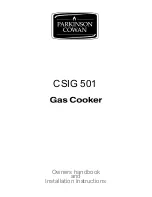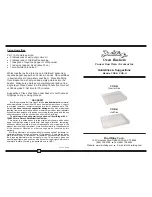
•
For correct operation, do not use coffee
with too fine a grind.
Figure 3.
Place the coffee jug (3), with
its lid fitted, on to the heating plate (2),
plug the appliance into the mains and
press the Café ON/OFF switch (1). The
pilot lamp indicates that the coffee maker
is working.
Figure 4.
A cup of coffee can be
served before the brew cycle has finished.
Whenever the jug is removed from the
heating plate, the coffee flow will be
detained temporarily.
Place the jug back on the heating plate
within 20 seconds.
PREPARING ESPRESSO (Fig. 5
- 10)
Figure 5.
Plug the appliance into the
mains and make sure that the ON/OFF
switch (7) is off. Close the steam regulator
(8) by turning it towards the sign.
Figure 6.
Unscrew the lid on the
tank (6) and pour in the desired amount
of water. Use the espresso jug (12) for
measuring. One cup of water equals one
cup of espresso. Screw the lid back on
and tighten it securely.
Figure 7.
Place the filter (11) into the
filter holder (10). Use the filter’s one, two
or threecup level marks to measure the
amount of powder needed. Clean off any
coffee powder that may be left around
the edge of the filter holder.
Important:
For best results, use a coar-
sely ground coffee, Italian espresso
type.
Do not pack t
he coffee powder.
Figure 8.
Use the
guide marks to
fit the filter holder and turn it to the right
until it locks. Place the espresso jug (12)
underneath so that the opening lines up
with the outlet for the espresso.
Figure 9.
If you want the espresso to
flow directly into two cups then fit the
adaptor on the filter holder.
Make sure that the water tank is closed
properly before using the espresso
maker.
Do not attempt to open the lid on the tank
while there is still pressure inside (for more
info see section «Important»).
Figure 10.
Press the Espresso ON/OFF
switch (7). The pilot lamp will light up and
after a short heatup time the espresso will
begin to flow out. When the flow stops,
turn the switch back to the OFF position.
Important:
• The tank can only be opened safely
when all the water has been used up and
there is no pressure inside it. To be certain
that there is no pressure inside the tank:
Switch the ON/OFF switch (7) to OFF
and unplug the appliance.
Place a jug full of water below the steam
nozzle (9).
Turn the steam regulator (8) towards the
sign.
When no more steam comes out, close
the steam regulator by turning it towards
the
sign.
• After usage the filter holder should be
left to cool down for a few minutes before
taking it out.
PREPARING CAPPUCCINO
(Fig. 9 -17)
Figure 11-12.
Follow the instructions
for making espresso. Use the level mark
on the espresso jug to measure the right
amount of water.
As soon as the first few drops of coffee
are forced through the filter holder you
can start frothing the milk.
Figure 13.
Place the tip of the steam
nozzle half way into a jug of cold milk.
Open the steam regulator by turning it
towards the sign. The excess water will
flow out through the espresso outlet.
Once the froth is ready, move the jug up
and down slightly to heat up the milk.
Figure 14.
To stop the steam coming out,
close the steam regulator by turning the
regulator to
.
Pour the frothedup milk onto the coffee.
If you want you can sprinkle it with
powered cinnamon or grated chocolate,
or decorate it with a stick of cinnamon.
Do not attempt to open the lid on the
tank while there is still pressure inside.
When you have finished remember to
bring the pressure down by following the
instructions stated in the previous point.
CLEANING & MAINTENANCE
(Fig. 15 - 18)
Figure 15.
Unplug the appliance from
the mains supply before proceeding to
clean it. Wash the moving parts with soapy
water. The drip tray (14) and the nozzle
cover can be removed for easy cleaning.
Wipe down the body of the coffee maker
with a damp cloth.
Figure 16.
It is necessary to clean
the steam pipe regularly to ensure that










































